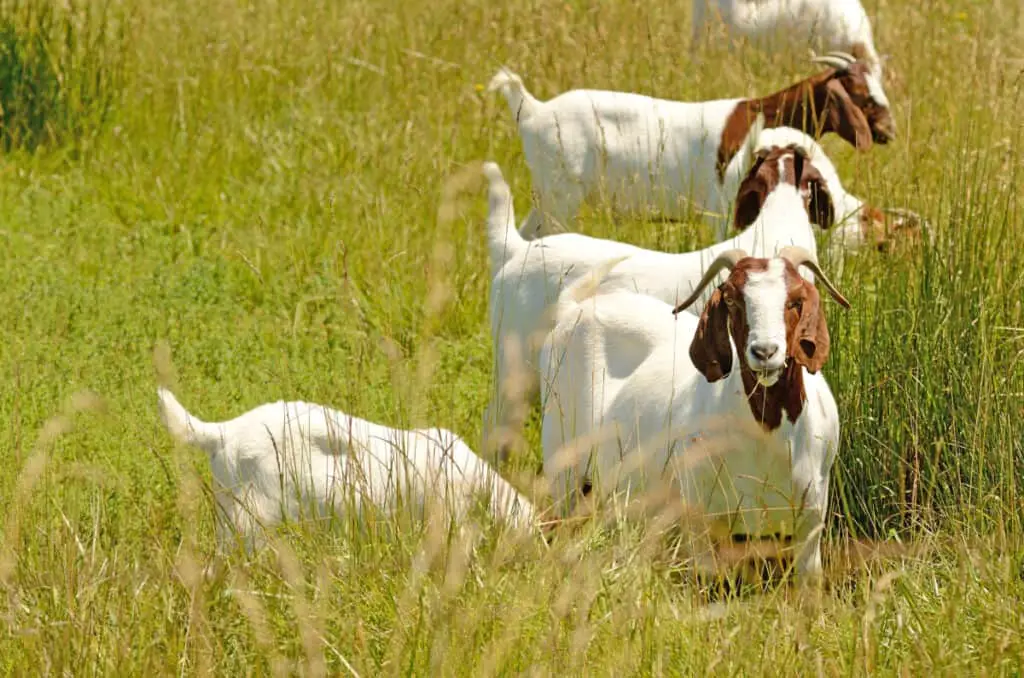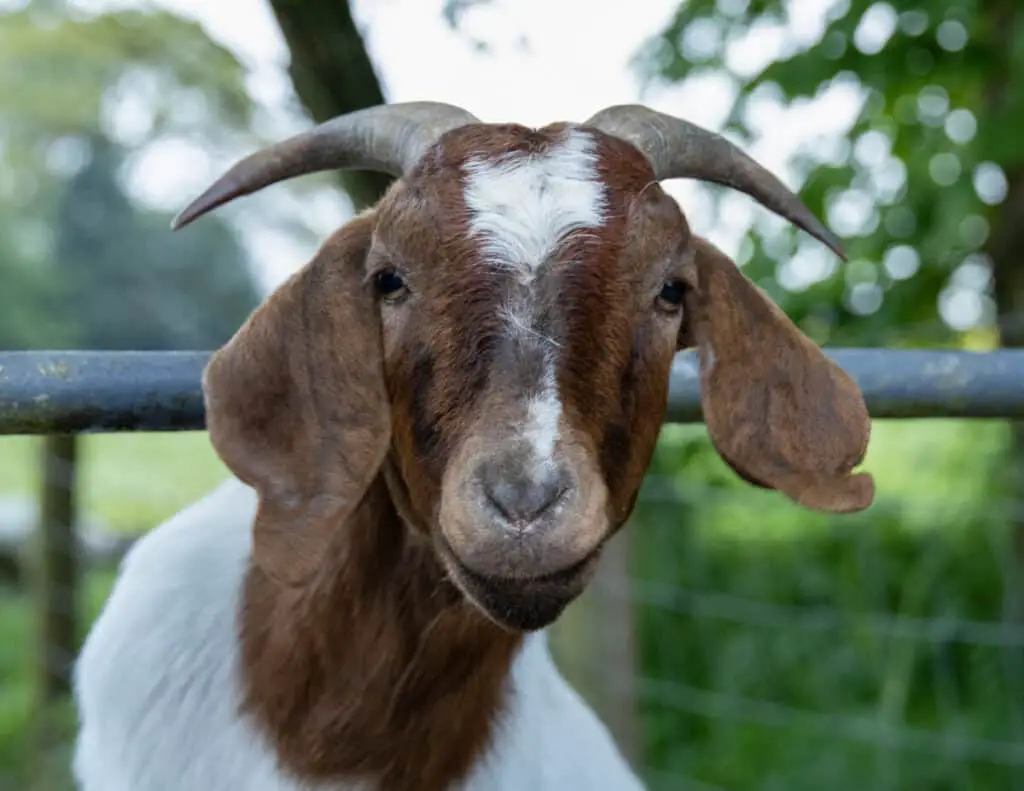The Boer goat is a breed of domesticated goats that originated in South Africa. It is known for its meat production, adaptability to harsh environments, and high reproductive rates.
The Boer goat’s popularity has increased worldwide due to its ability to produce large quantities of lean meat with minimal feed requirements.
Boer goats are medium-sized animals with short hair, long ears, and a distinctive white body coloration with brown heads. They have strong bones and muscular bodies, making them ideal for meat production.
Their hardiness allows them to thrive in different climates and terrains from arid regions such as the African savannah to humid tropical areas or even cold temperate zones.
Additionally, their reproductive rate is impressive; they typically give birth twice per year, producing two kids each time on average. Due to these traits, the Boer goat has become popular among farmers seeking profitable livestock breeds.

Origin And History Of The Boer Goat
The Boer goat, a domesticated breed of goat that originated in South Africa, has garnered attention worldwide due to its meat production and adaptability. This breed is part of the evolutionary lineage of wild goats which were originally found in Asia, Europe, and Africa.
As time progressed, these wild goats dispersed throughout various regions around the world and evolved into different breeds according to their environment.
In South Africa, where the Boer goat was developed during the early 1900s by Dutch settlers, this particular breed held cultural significance as it played an important role in providing food for local communities. The Boer goat’s ability to thrive in arid environments made it particularly valuable for farmers living in harsh conditions with limited water resources.
Today, the Boer goat has gained popularity globally because of its high-quality meat production and its ability to adapt to various climates and terrains without compromising its productivity or resilience.
Characteristics And Physical Features Of The Boer Goat
The Boer goat, originally from South Africa, has a rich history and background. It was first bred in the early 1900s by Dutch farmers who wanted to improve the meat quality of their goats. The breed quickly gained popularity due to its fast growth rate and high-quality meat production.
In the late 1980s, Boer goats were introduced to other countries, including the United States and Australia, where they also became popular for their adaptability to different climates.
Breeding patterns play an important role in maintaining the genetic diversity of Boer goats. They are typically bred through natural mating or artificial insemination. Breeders may choose specific breeding methods based on factors such as desired traits in offspring or limitations in herd size.
Nutritional requirements of Boer goats include a balanced diet that consists of hay, grains, and minerals. Adequate intake of nutrients is essential for optimal health and productivity. Proper nutrition during pregnancy is especially crucial for successful kidding and healthy offspring development.
- A well-nourished doe can produce more milk and raise healthier kids.
- Providing access to clean water at all times promotes hydration and overall health.
- Regular veterinary care helps prevent diseases and ensures proper healthcare management.
It is evident that understanding breeding patterns and nutritional requirements are crucial aspects when it comes to managing a herd of Boer goats effectively. By providing ample nourishment while keeping track of relevant breeding information, farmers can ensure optimal productivity levels within their herds while simultaneously promoting good health among individual animals.
Advantages Of Boer Goats For Meat Production
Boer goats are highly sought after for their meat production, and they offer several advantages over other breeds.
One of the primary benefits is their high nutritional value. Boer goat meat is a rich source of protein and contains low levels of fat, making it an ideal choice for health-conscious consumers.
Additionally, this breed’s meat has a unique flavor that sets it apart from other types of red meat. Cooking methods are another advantage to using Boer goats for meat production.
The lean nature of the meat requires special attention when cooking to prevent it from becoming tough or dry. Slow-cooking techniques such as braising or stewing can help retain moisture while tenderizing the meat.
Alternatively, grilling or broiling can be used to quickly sear the outside and lock in juices before finishing in a lower heat oven or on indirect heat on the grill.
Overall, these advantages make Boer goats an attractive option for those looking for nutritious and flavorful meat products.
Adaptability To Different Environments And Climates
The Boer goat is a highly adaptable breed that thrives in various environments and climates. Its hardiness, resistance to diseases, and high fertility rate make it an excellent choice for farmers looking for low-maintenance livestock.
The adaptability of the Boer goat comes from its origin as a South African breed developed specifically to withstand harsh conditions such as droughts, hot temperatures, and poor feed quality.
Crossbreeding potential is another factor that contributes to the adaptability of the Boer goat. They have been successfully crossbred with other breeds like Spanish goats and Kiko goats to create hybrid breeds that exhibit desirable traits from both parent breeds. These hybrids can then be used in different regions where local climate or environmental factors may not favor purebred Boer goats. However, while crossbreeding can enhance certain characteristics of the Boer goat, health considerations must also be taken into account when selecting breeding partners.
In terms of overall adaptability, the Boer goat has proven itself to be a versatile breed capable of thriving in different environments and climates. With proper care and management practices, they can continue to provide economic benefits for farmers worldwide.
While there are still challenges associated with raising them under extreme weather conditions or disease outbreaks, their resilience and ability to cope with stressors make them valuable assets for any agricultural enterprise seeking reliable animal production systems.
Reproductive Rate And Breeding Of Boer Goats
The reproductive rate of Boer goats is an important factor in the profitability and sustainability of goat farming.
The average gestation period for goats is around 150 days, with most does giving birth to twins or triplets.
However, proper breeding techniques are necessary to maintain a high reproductive rate.
Breeding should be timed carefully to ensure that the doe conceives at optimal times, which can vary based on factors such as age, weight, and overall health.
Reproductive health also plays a significant role in maintaining a high reproductive rate among Boer goats.
Proper nutrition and regular veterinary care are essential to minimize the risk of infections and other diseases that can impact fertility.
Additionally, farmers must monitor their goats closely during mating season to prevent injuries or stress that could negatively affect reproduction.
By implementing these strategies and paying close attention to the unique needs of individual animals, farmers can optimize their breeding programs and achieve maximum productivity from their herds.
- Select healthy males and females
- Monitor animals for signs of heat
- Use artificial insemination when needed
Boer Goat Farming And Business Opportunities
Boer goat farming has proven to be a profitable business opportunity, especially in areas with high demand for meat. The Boer goat breed originated from South Africa and is known for its fast growth rate, large size, and high-quality meat. These characteristics make it an ideal choice for farmers looking to raise goats for commercial purposes.
Marketing strategies play a crucial role in the success of any business venture. In the case of Boer goat farming, marketing efforts should focus on promoting the quality of the meat produced by these animals. Farmers can leverage social media platforms such as Facebook and Instagram to showcase their products and reach potential customers.
Additionally, participating in local farmer’s markets or partnering with restaurants that specialize in serving exotic meats can help expand market reach. It is also important to educate consumers about the nutritional requirements of Boer goats’ diet so that they understand the health benefits associated with consuming this type of meat.
Nutrition plays a vital role in ensuring healthy growth and development of Boer goats. They require a balanced diet consisting of hay, grains, protein supplements, and minerals such as calcium and phosphorus. Farmers need to ensure that their goats have access to clean water at all times since dehydration can negatively affect growth rates.
By providing proper nutrition, farmers can achieve maximum weight gain within a shorter period while maintaining good health standards among their herd. Overall, Boer goat farming offers numerous opportunities for entrepreneurs seeking to invest in livestock production ventures that offer significant returns on investment without requiring extensive land or resources.

Conclusion
The Boer goat is a breed of domesticated goats that originated from South Africa. These goats are known for their high meat production quality and excellent reproductive rates, making them an ideal choice for commercial farming.
They have distinctive physical features, including a solid red or white coat color, large size, and muscular body. Boer goats also possess unique adaptability traits to different environments and climates, which makes them suitable for various agricultural purposes.
Their remarkable breeding rate has led to the development of many successful boer goat farms worldwide. Additionally, business opportunities in this industry continue to grow due to the increased demand for goat meat.
In conclusion, the Boer goat is a highly valuable asset in agriculture due to its numerous benefits such as adaptability, meat production qualities, and rapid reproduction rates. The potential economic gain from owning these animals can be significant when managed appropriately.
Therefore, investing in Boer goat farming could provide profitable returns while contributing positively to food security globally.

